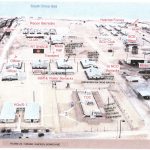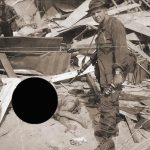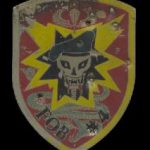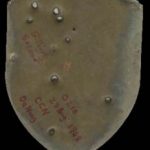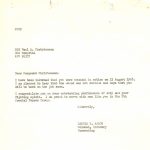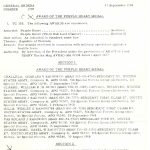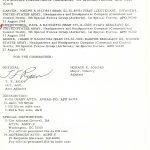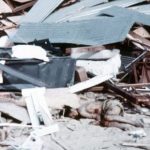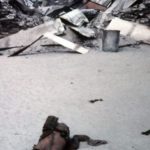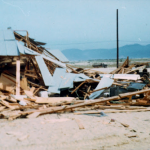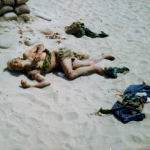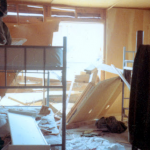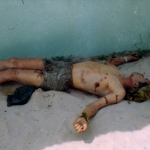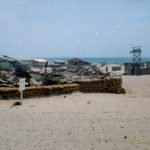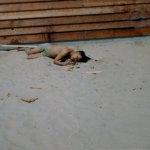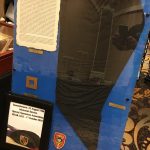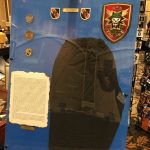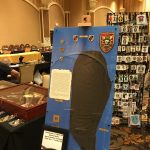23, August 1968 FOB-4 CCN
Written by John S. Meyer
Marble Mountain was honeycombed with caves and trails. South along the China Sea, the beaches were flat. Abruptly, the two rugged peaks of Marble Mountain jutted up, and cradled between them was a pagoda, complete with monks who protested whenever U.S. troops got too close to their holy temple–but apparently didn’t seem to mind having NVA or Viet Cong cadre around.
In support of the conclusion that the NVA had infiltrated agents inside the camp is the fact that the NVA launched this attack when the number of soldiers within FOB 4 had swelled well beyond normal: There was an enlisted promotion board held the previous day; all of the FOB commanders, executive officers and their respective S-3 and S-2 officers held their monthly meetings earlier in the day; that, in addition to the fact the population had grown when the CCN headquarters was recently moved from downtown Da Nang to FOB 4, thus making it FOB 4/CCN.
By the time the NVA sappers hit the camp, there had to be at least twice, maybe three times as many Special Forces troops in the camp as were normally assigned there,” recalls Watkins, who was in his second tour with MACV-SOG, at that time out of FOB 1, and had appeared before the promotion earlier in the day.
The spirit earlier that fateful day was “typical of any promotion board gathering,” Watkins said. “There was a lot of drinking, a lot of partying and general hell-raising” by the Special Forces troops. With any promotion board, the drinking was usually heavy because many soldiers hadn’t seen each other for extended periods of time, and at these gatherings, they tended to make up for the months apart during one day’s heavy drinking.
Inside Without A Shot
As America’s elite partied into the night, NVA sappers quietly prepared for their attack. One company dressed in white loincloths, with white headbands and a piece of white material attached to their Aks. The last company wore red.
The NVA troops began infiltrating through the thin wire in the southeast corner of the camp. For months, locals who worked at FOB 4 returned home through the wire. On that night, the NVA marched right into camp, heavily armed and carrying satchel charges.
Sometime after 0100 “all hell broke loose,” said former Green Beret Sergeant Ronald D. “Red” Podlaski. “At first, I though we were taking incoming.” What many thought were incoming rounds were satchel charges exploding throughout the compound.
One company attacked the American recon huts which sat in three north-south rows, on the eastern side of the camp. Another company of NVA nit the TOC, destroying it and damaging the commo center. Other sappers hit the officers’ quarters and transient barracks at the northwestern quadrant.
Podlaski was a team leader in recon company at FOB 4/CCN. The NVA sappers with satchel charges went up to the front door and threw charges into each plywood hut, which housed two to six Gis.
A medic who was staying with Podlaski that night later recounted: “We were lucky. The front door on our hootch had an extra-strong spring on it, so that the door was hard to open…When the sappers came to our hootch, they pulled open the door and threw the satchel charge. But the spring was so strong, the door closed so quickly that the charges bounced off the door and blew up the front steps.”
There was so much confusion and pandemonium the medic and Podlaski didn’t realize what had happened outside. “Hell, when we ran outside we didn’t realize the steps had been blown away so we fell ass over head,” Podlaski recalls.
As Podlaski and the medic fell, an NVA sapper opened fire on full automatic, shooting high: “He fired where he though we were going to be running. If we hadn’t fallen, he probably would have gotten us…Running recon in CCN we had plently of close calls in the field,” said Podlaski, who ran more than a dozen targets in Laos and Cambodia during his tour with MACV-SOG, “but I remember hitting he sand and disbelieving that the closest call of all for em was right there in camp, in CCN, when that sapper opened up on us. Unbelievable!”
A South Vietnamese CCN recon team member killed the sapper, as the indigenous troops rallied from their quarters.
Watkins was asleep in the BOQ along the northern quadrant of the camp because the transient billets were packed with people who had gone before the promotion board earlier in the day.
Like Podlaski, Watkins and several of the officers “were awakened by the explosions,” Watkins said. : thought we were taking incoming at first. Then, I realized we weren’t taking incoming and simultaneously, I regretted having given my Swedish K [to a friend] that night.
“All I had was my old Colt .45, which was in my flight survival vest…the NVA had knocked the air conditioners out of the wall and pushed several satchel charges into the building through the holes…”
As Watkins crawled down the hallway, several explosions ripped through the building. He rubbed his eyes in disbelief as he saw two officers looking out a nearby window. “I told the officers to get down on the floor or they weren’t long for this world.”
By then men in the camp began to put up flares, lighting the camp-turned-battlefield.
At some point, an AC-130 Spectre gunship with fore miniguns and two 20mm cannons arrived over CCN.
“Specter did a hell of a job,” Watkins said. “They dropped flares and caught some NVA, in the wire, plus they were able to hit a couple of pockets of NVA in the camp.”
Good Morning, Vietnam
At first light, Lieutenant Colonel Roy Bahr lead a relief force from FOB 1 down the coast of the China Sea into FOB 4, clearing all NVA sappers who had escaped along the beach from the camp after Spectre arrived.
Also at first light, SF troops tracked two NVA soldiers to an outside latrine at the northeast corner of the compound. Accounts of this are mixed: One officer said the NVA killed themselves with a frag grenade; a second account said the SF troops opened fire on the latrine, venting pent-up anger over the carnage wrought by the daring NVA night attack.
Staff Sergeant Robert J. “Spider” Parks returned to FOB 4/CCN shortly after first light. “It was a sight I’ll never forget,” Parks reminisced recently. The road into camp ran from the highway along the northern edge of the perimeter, with turn-offs for the helicopter pad, headquarters, and at the eastern end of the road, for the NCO club, mess hall and Recon Company.
As Parks walked down that road “it looked like a hazy movie scene. There was a haze hanging over the camp–you could still smell the cordite from all the weapons fire. People were running around, some of them still dazed by the night’s tragic events…
“There were still some sappers around in the camp and snipers firing down from Marble Mountain. The NVA fired on the ambulances leaving camp as well as the one pulling in. People in the camp got organized and linked up with the relief force Colonel Bahr brought in from Phu Bai.”
Parks pulled out his camera and took pictures of the dead enemy, including the NVA soldier Watkins killed with his .45. Some are included here.
Later that day, Watkins and several SF and indigenous recon troops went to Marble Mountain and found the sand table the NVA had used to rehearsed their attack on FOB 4/CCN.
The Enemy Within
There were several facts about the attack which were confirmed by Watkins and numerous survivors interviewed shortly after the FOB 4/CCN massacre:
* “It was obvious they had worked months on the attack…the NVA had good intelligence from inside the camp which helped them pick that night for the attack,” Watkins said.
* Prior to the attack, warning about security problems along the southeast perimeter, where locals walked through the barbed wire, were ignored. Additionally, the local security force appeared to cooperate with the NVA instead of defending the camp. NVA weapons and satchel charges had been cached inside FOB 4/CCN.
* The attack could have been worse: Some NVA troops carried maps which the local Viet Cong had drawn upside down. Thus, they ignored the indigenous recon billets at the southeastern corner of the compound, instead hitting the BOQ at the northern side of the compound. “That was a major mistake, because the recon indig reacted quickly and severely hurt the NVA that night. In ‘68, the indig at FOB 4 were outstanding and they stood tall that night,” Watkins said.
* “We were very fortunate in another aspect,” said Bahr, “because after our commanders meeting, many of us flew back to our FOBs. Thus, when we heard about the attack, I was able to put together the reaction force. We flew down in Kingbees (Vietnamese-piloted H-34s) before first light…otherwise the losses could have been much more crippling.”
* Many SF troops reacted slowly because there was too much boozing the previous night.
* The total of 16 SF troops killed at FOB 4/CCN “was the heaviest USASF loss in a single incident in SF history,” according to Green Beret magazine. Plus, “In the subsequent three days, eight more USASF were killed, six at Duc Lap”–Special Forces A Camp (A-239).
Killed in the Attack
Special Operations Association
August 22, 2019
August 23, 1968 marks what was known for many years as the worst day in Special Forces History – the attack on the MACV-SOG camp FOB-4 near Da Nang, Vietnam, also referred to as the Battle of Marble Mountain. Sixteen men were killed during the attack, the most SF men killed in a single battle, a dark record that still stands today. While stories about battlefield displays of courage by Special Forces men abound, and names such as Lang Vei and Khe Sahn have become legend, the story of FOB-4 seems to have faded from memory along with the grizzled old team sergeants who served in Vietnam. In 1968 Special Forces was still a small community, and almost every man wearing the Green Beret knew one of the sixteen men who died during the attack.
With time and study, the many short comings that allowed 100 sappers to slip into FOB-4 under the cover of darkness during the night of 22-23 August have become clear. Poor perimeter defenses, both in the physical barriers and the guard force; leaderships disregard for intelligence reports about the enemy build up in the area; a local workforce compromised by enemy agents and a strong sense of false security within the camp. These errors in leadership can’t be ignored, but they fall on the command, and should not cast a shadow over the rank and file men of FOB-4.
By the time the sun rose on the morning of 23 August, actions taken by the men in the camp would result in one Distinguished Service Cross, four Silver Stars, 11 Bronze Stars w/Valor device, eight ARCOM’s w/Valor device and 66 Purple Hearts being awarded. Over one third of the men in the camp were wounded or dead.
It was a great blow to the Special Forces family, but an even greater blow to the families of the casualties. Eleven women were suddenly widows, several with young children to raise; fourteen boys lost their fathers; nine daughters lost the man who would have walked them down the aisle; fourteen young men lost a brother they expected to always have; sixteen young women lost a brother they idolized and twenty-seven moms and dads faced the unthinkable, losing a child before their own deaths. That’s ninety-one people who had their world forever changed in the few hours of the attack on FOB-4.
In 2018 the SOA marked the 50th Anniversary of this terrible event by bringing together many of the families of the fallen with men who survived the attack so all could be honored. There was also a gathering at the Vietnam Veterans Memorial organized by SOG veteran Dan Thompson on the 50th anniversary.


